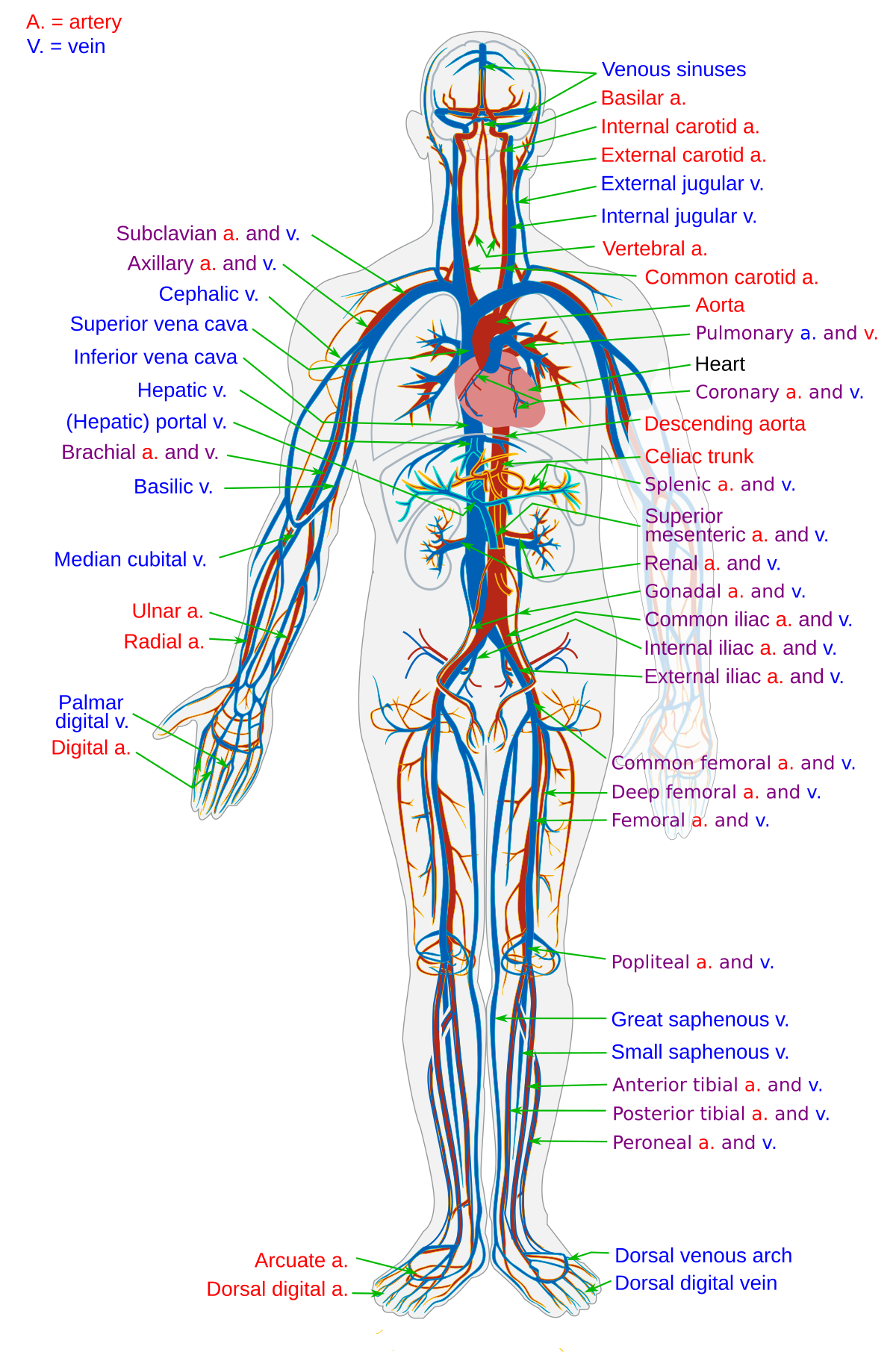Major Blood Vessel Chart | These vessels transport blood cells, nutrients, and oxygen to the tissues of the body. Blood vessels are the body's highways that allow blood to flow quickly and efficiently from the heart to every region of the body and back again. Hma practical 3 virtual slides. Blood vessels are often named after either the region of the body through arteries are blood vessels that carry blood away from the heart. The dashed lines represent subdivisions within a major categorization.
Blood vessels were part of the circulatory system and functioned to transport blood throughout humanoid bodies. The left ventricle of the heart pumps oxygenated blood into the aorta. Let's have a look.daily anatomy app:for a random. Attaches vessel to neighboring structures. Anastomoses are especially common in veins, where they help maintain blood flow even when one vessel is blocked or narrowed, although there are some important ones in.

Allows diffusion of gases and nutrients from blood into the body cells. Major blood vessels, blood vessels. Carry blood towards the heart (usually deoxygenated blood, except for the pulmonary vein). The major (or great) blood vessels of the heart are the larger arteres and veins that attach to the atria and ventricles and transport blood to and approximately two inches superior to the base of the heart, this vessel branches into the left and right pulmonary arteries, which transport blood into the lungs. Blood carried by arteries is usually highly oxygenated, having just left the lungs on its. From there, blood passes through major arteries, which branch into muscular arteries and then. Supplies the posterior brain, blood supply to the entire brain is. Blood vessels are often named after either the region of the body through arteries are blood vessels that carry blood away from the heart. They also take waste and carbon dioxide away from the tissues. This chart is a simple list of vessels that contains a bunch of calculated numbers. Blood vessels are the body's highways that allow blood to flow quickly and efficiently from the heart to every region of the body and back again. Blood is oxygenated in capillaries that flow through the alveoli of the lungs. The main vessels that run through the neck are the external jugular vein (and its tributaries), the internal jugular vein (and its tributaries), and the common carotid artery, which then splits into the internal and external carotid arteries (whic.
Does not cover the pathology content. They also happen to correlate much more loosely to those. Blood flows throughout the body tissues in blood vessels, via bulk flow (i.e., all constituents together and in one direction). The arteries are major blood vessels connected to your heart. Veins return blood back toward the heart.

Hma practical 3 virtual slides. Does not form part of the actual practical class based upon the virtual slides. Blood vessels are the body's highways that allow blood to flow quickly and efficiently from the heart to every region of the body and back again. The major (or great) blood vessels of the heart are the larger arteres and veins that attach to the atria and ventricles and transport blood to and approximately two inches superior to the base of the heart, this vessel branches into the left and right pulmonary arteries, which transport blood into the lungs. The aortic and pulmonic valves lie between the ventricles and the major blood vessels leaving the heart. The other system, the systemic vessels, carries blood from the left ventricle to the tissues in all parts of the body and then returns the blood to the right atrium. These vessels transport blood cells, nutrients, and oxygen to the tissues of the body. Blood vessels are the channels or conduits through which blood is distributed to body tissues. Normal blood pressure range chart, with comments about each blood pressure level. Blood vessels are often named after either the region of the body through arteries are blood vessels that carry blood away from the heart. Malnutrition, vitamin deficiencies, anemia (lowered ability to carry blood vessels). Arteries transport blood away from the heart. Does not cover the pathology content.
Veins return blood back toward the heart. Oxygenated blood is then returned to the left atrium of the heart by four pulmonary although the internal carotid a. High, normal and low blood pressure are defined. Carry blood towards the heart (usually deoxygenated blood, except for the pulmonary vein). This chart is a simple list of vessels that contains a bunch of calculated numbers.

A blood vessel is any of the tubular channels that convey blood throughout the body, whether arteries (including threadlike arterioles) that convey blood away from the heart, veins (including threadlike venules) that convey blood toward the heart, or the tiny capillaries that connect arterioles and venules. Normal blood pressure range chart, with comments about each blood pressure level. How well do you know the anatomy here? Major blood vessels, blood vessels. The other system, the systemic vessels, carries blood from the left ventricle to the tissues in all parts of the body and then returns the blood to the right atrium. Arterioles connect with even smaller blood vessels called capillaries. Blood vessels are often named after either the region of the body through arteries are blood vessels that carry blood away from the heart. Blood carried by arteries is usually highly oxygenated, having just left the lungs on its. High, normal and low blood pressure are defined. The aortic and pulmonic valves lie between the ventricles and the major blood vessels leaving the heart. From there, blood passes through major arteries, which branch into muscular arteries and then. These vessels transport blood cells, nutrients, and oxygen to the tissues of the body. Does not cover the pathology content.
Major Blood Vessel Chart: Create a flow chart showing the major systemic arteries through which blood travels from the aorta and its major branches,.
Refference: Major Blood Vessel Chart
0 komentar